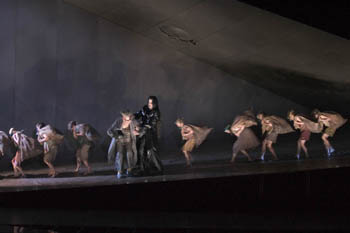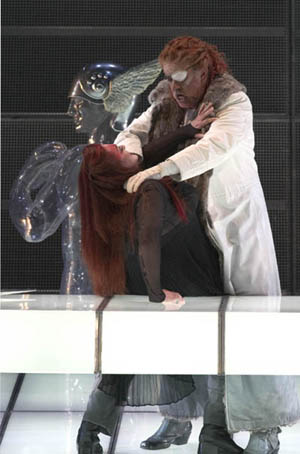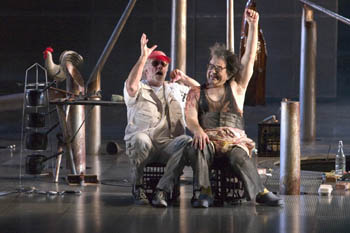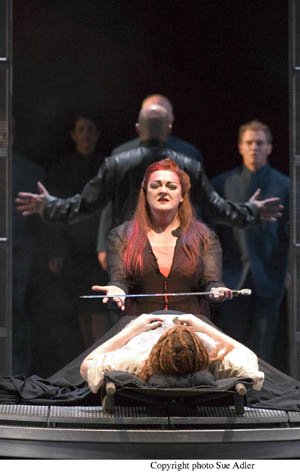|
Seen and Heard
International Opera Review
Der Ring Des Nibelungen,
State Opera of South Australia, Adelaide Festival Theatre, 16-22 November
2004 (RW)
There is a pervading sense of relief and pride in Australia after
the triumphant premiere of the Adelaide production of the Ring.
It worked, Australia can do it, we pulled it off!
It’s not just the logistical feat that the State Opera of South
Australia has achieved in premiering Wagner’s entire Ring
cycle in one week. There’s also an excitement that Australia
can contribute to the world of opera at such a high level.
Local critics have been raving, and much of it really was that good.
Director Elke Neidhardt set out to tell the story clearly, working
closely with her design team to produce a cycle with vivid characterisation
and beautiful sets. The creative teamwork of Nick Schlieper (lighting),
Michael Scott-Mitchell (sets), and Steven Curtis (costumes) has taken
the production to a superior level with its dramatic synthesis of
story, lighting and sets.

From the opening of Das Rheingold it was immediately apparent
this would be an original and entertaining realisation of the Ring.
The stage was hung with a clear membrane, down which sheets of water
flowed, sparkling in the blue light. It made a beautiful river Rhine
in front of which the Rhinemaidens (Natalie Jones, Donna-Maree Dunlop,
and Zan McKendree-Wright) cavorted in wetsuits and goggles.
The gods were introduced lolling idly on a vividly lit, clean-lined
stage. Bedecked in white chic elegance, their starched appearance
faded as the cycle continued and the divine went into decline. Fricka
(Elizabeth Campbell) and Freia (Kate Ladner) were manicured and glossy.
Froh (Andrew Brunsdon) looked slightly camp in his frock coat, while
Donner (Timothy Dufore) ran around in a tracksuit with a lightening
bolt shaved into his hair. Their singing was excellent, and they made
a spoof of the anxious materialism and arrogance of the gods.
It wasn’t all convincing though. The god’s sanitised whiteness
looked spineless next to the sexy black leathers of Alberich (a slimy,
sinister John Wegner with a midnight voice). Wotan (John Bröcheler)’s
lack of nobility right from the start meant he had nowhere else to
go in the following operas. His character was so pathetically vain
and greedy that he didn’t inspire sympathy when brow-beaten
by Fricka, or invite the adulation Brünnhilde gives him in Die
Walküre. Christopher Doig was the other weak link in Das
Rheingold, with a pitch-challenged performance of the trickster
Loge that had no sparkle, even though the music was flickering and
cunning. These concerns aside, the comedy was a convincing introduction
to Alberich and Wotan and their gamble with love and money. The audience
were swept away by the entertainment, responding with a standing ovation.

Die Walküre continued in the same line, with an innovative
use of stage space and a focus on humour rather than pathos. There
were concerns the highly publicised technological effects would dominate
the opera so it was a relief to discover that the spectacular set
designs enhanced the drama rather than detracted from the story. In
the end it wasn’t the expensive ring of fire or the shimmering
Rhine water curtain that elicited the greatest response from the audience.
Scott-Mitchell’s design coup was in the opening of Act III of
Die Walküre.
Where do the Valkyrie warrior princesses meet after a hard days work?
At the pub for a drink of course! Roll in the white “Wunder
Bar”, complete with bar stools, TV monitors, huge bubbling cones
of champagne and blue beer, where the leather clad, pink haired girls
lounge around in style. The only reference to more traditional Valkyrie
interpretations was the token horned helmet adorning the glowing signage.
Far from ruffling purist Wagnerite feathers, the Wunder Bar appealed
to the famous Australian larrikin sense of humour and was a huge success.
The other highlight to Walküre was Lisa Gasteen’s
arrival as a thrilling Brünnhilde. In this plot-based production
she captured every shade in Brünnhilde’s character, from
tender daughter to headstrong warrior. With a tone to die for (lush
low register and searing high notes) and complete dramatic conviction,
Gasteen has established herself as one of the great Wagnerian sopranos
of our time, and one of Australia’s greatest achievements.

Unfortunately her Siegfried could not match her. At the last minute
American tenor Timothy Mussard had to withdraw from his title role
in Siegfried, suffering damaged vocal ligaments. Mussard returned
in Götterdämmerung and battled valiantly, but his
hoarseness towards the end gave cause for concern at the damage he
may be doing to his voice.
His replacement, Gary Rideout, gave a dramatic performance of the
hero, all the more impressive because he had not been to the dress
rehearsals. He swaggered around in orange corduroys and dread-locks
with playfulness and aggression, although his voice didn’t last,
fading alarmingly towards the end.
The design team’s fresh ideas seemed to run out in Siegfried,
leaving it a bit flat alongside the other operas. There were conflicting
symbols and ideas, and some weak dramatic moments. Siegfried was more
terrible two-year-old than innocent young hero; Mime and Siegfried’s
affectionate squabbling relationship generated more sympathy than
the supposedly noble family of gods, and the mighty downfall of Fafner
the dragon, represented by a huge clawed machine arm, was cheapened
by the finger sign gestured at Siegfried – an out-of-place attempt
at comic gesture. Then of course there was the all-consuming love
duet as Brünnhilde wakes to her hero – who spent most of
the scene with his back to his beloved.
Siegfried is a hard opera to pull off with its mystical,
fairytale qualities, and often it is only the music that can portray
the internal story. Fortunately Asher Fisch was a tremendously supportive
conductor, closely following the drama on stage throughout the cycle.
Under his direction the Adelaide Symphony Orchestra held together
this third opera. The orchestra’s woodwind murmurings in the
forest scene created an aural landscape for Siegfried to wander through,
delicate and voluptuous.

Götterdämmerung was a return to the momentum of
the first two operas. Striking red arches in the Hall of the Gibichung
were arranged in a pattern kiltering out of sequence, symbolising
the natural order spiralling out of control. The gods have faded completely,
with Wotan now a hobbling grey geriatric, and the power lying with
Alberich and his son Hagen. The humans are simply tools along the
way, with Gunther a weak military figure and the unmarried Gutrune
questionably portrayed as a crippled frump.
In Act II Brünnhilde’s reunion with Siegfried provided
another opportunity for the design team to highlight the drama. Siegfried,
now partnered with Gutrune, appears dressed in full bridal regalia,
and Brünnhilde’s sudden recognition of her lover was heartbreaking,
with Gasteen moving from whispered regret to shrieking anger.
Brünnhilde alone retains any nobility in this production which
seeks to emphasise the comic and the flawed. It makes the final moments
horribly tragic as the heroine ends the corruption with her own sacrificial
death.
It is left to Erda to bring the cycle to a more positive close, ending
as it had begun with her Buddha-like figure appearing behind the water
curtain, now nurturing a sapling ash tree and heralding the beginning
of a new cycle. The suggestion of the cyclic nature of greed and corruption
is a quiet challenge to our own culture and its contemporary response
to the same problems.
Individual mention must be made of Richard Greager as a delightfully
bumbling Mime, serving spam with a flourish, and dancing with glee
in the riddle competition with Wotan. The supporting cast were terrific,
demonstrating the power of combining top singing with intelligent
dramatic gesture. This production will only improve in the following
two cycles as the singers relax and the orchestra settles in.
Neidhardt hasn’t created an overtly “Australian Ring”
and it is obvious she had no intention of conveying any political
messages within the production. But the uncluttered story-telling,
together with a brilliant cast and plenty of room for the orchestral
accompaniment to work its subliminal magic, produced a Ring that was
profound and deeply engaging. The Adelaide Ring will be remembered
as a fresh, humorous and beautiful production which tells Wagner’s
story in a way that is relevant not just to Australians, but to all
humanity.
Rosalind Wadley
Review © The Opera Critic
and photos © Sue Adler
Back to the Top
Back
to the Index Page
|

